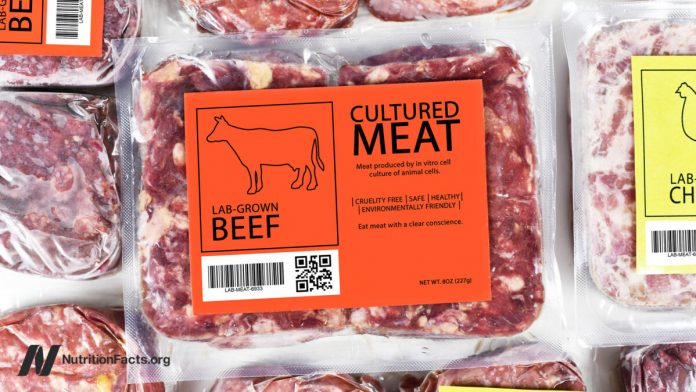What are the direct health implications of making clean meat—that is, meat without animals?
In a 1932 article in Popular Mechanics entitled “Fifty Years Hence,” Winston Churchill predicted that we would one day “escape the absurdity of growing a whole chicken in order to eat the breast or wing, by growing these parts separately under a suitable medium.” Indeed, growing meat straight from muscle cells could reduce greenhouse gas emissions by as much as 96 percent, lower water usage by as much as 96 percent, and lower land usage by 99 percent.
If we are to avoid dangerous climate change by the middle of the century, global meat consumption simply cannot continue to rise at the current rate. And there have certainly been initiatives like Meatless Mondays to try to get people to cut down, but so far, “they do not appear to be contributing in any significant way to the translation of the idea of eating less meat into the mainstream.” So, “in the light of people’s continued desire to eat meat, it seems the problems associated with consumption are unlikely to be fully resolved by attitude change. Instead, they must be addressed from an alternate perspective: changing the product.”
From an environmental standpoint, it seems like a slam dunk. From an animal welfare standpoint, it could get rid of factory farms and slaughter plants for good, and I wouldn’t have to stumble across articles like this in the scientific literature: “Discerning Pig Screams in Production Environments.” I mean, what more do we need to know about modern animal agriculture than the fact that, “in recent years, a number of so-called…‘ag-gag’ laws have been proposed and passed…across the USA,” banning undercover photographing or videotaping inside such operations to keep us all in the dark.
What about the human health implications of cultivated meat? I get the animal welfare, environment, and food security benefits, but what about “the potential for cultured meat to have health/safety benefits to individual consumers”? Nutritionally, the most important advantage is being able to swap out the type the fat. Right now, producers are growing straight muscle tissue, so it could be marbled with something less harmful than animal fat, though, of course, there’s still animal protein.
When it comes to health, the biggest, clearest advantage is food safety, reducing the risk of foodborne pathogens. There has been a sixfold increase in food poisoning over the last few decades, with tens of millions “sickened annually by infected food in the United States alone,” including hundreds of thousands of hospitalizations and thousands of annual deaths. Contaminated meats and other animal products are the most common cause.
When the cultivated meat industry calls its products clean meat, that’s not just a nod to clean energy. Food-poisoning pathogens like E. coli, Campylobacter, and Salmonella are fecal bacteria. They are a result of fecal contamination. They’re intestinal bugs, so we don’t have to worry about them if we’re making meat without the intestines.
Yes, there are all sorts of “methods to remove visible fecal contamination” in slaughter plants these days and even experimental imaging technologies designed to detect more “diluted fecal contaminations,” but we are still left at the retail level with about 10 percent of chicken contaminated with Salmonella and 40 percent of retail chicken contaminated with Campylobacter. What’s more, most poultry and about half of retail ground beef and pork chops are contaminated with E. coli, an indicator of fecal residue, as shown here and at 3:47 in my video The Human Health Effects of Cultivated Meat: Food Safety. We don’t have to cook the crap out of cultivated meat, though, because there isn’t any crap to begin with.
Doctor’s Note:
This is the first in a three-video series on cultivated meat. Stay tuned for The Human Health Effects of Cultivated Meat: Antibiotic Resistance and The Human Health Effects of Cultivated Meat: Chemical Safety.
I previously did a video series on plant-based meats. Check them in the related posts below.
The videos are also all available in a digital download from a webinar I did: The Human Health Implications of Plant-Based and Cultivated Meat for Pandemic Prevention and Climate Mitigation.



